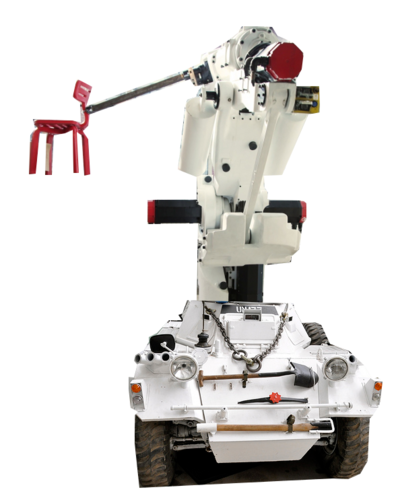Joris Peels proposes a radical idea for 3D printing: mobility. Longtime Fabbaloo readers will be familiar with the concept of a “build chamber”, in which extruders or other printing mechanisms move about to create an object. The build chamber is based on the mechanical concept of three axes of movement, but it has a major limitation: objects must fit within the build chamber. If not, the extruder would have to “leave” the build chamber. That’s not mechanically possible.
Peels proposes a different approach: abandon the “build chamber” concept entirely and use a robot arm mounted on a moveable chassis. 3D printing has previously been done with robot arms, but providing mobility would permit the arm to reach infinitely, enabling building massive objects. Erm, at least as high as it can reach, anyway.
The resulting “printer” might look like Peels’ concept “TankPlusArm” above.
We like this idea and believe someone should give it a try, but we see a couple of challenges:
Safety. Moving mechanical parts are always dangerous and by keeping them within an explicit build chamber, we’ve “captured” the danger zone. Keep your hands out when printing! This won’t be the case with a mobile 3D printer. We may have to fence them in and restrict access while printing takes place, although coding errors could generate some terrific YouTube videos.
Time. Extrusion-based 3D printing is very time consuming, as the print head must literally move over every solid spot on the printed object. Printing large-scale objects will simply aggravate the problem by introducing much more movement, and therefore increasing print time. Prints might take weeks using this approach.
What do you think?
Via VoxelFab



So why not parallelize it – use multiple mobile printers – dozens of them – swarms. Have swarms of robots all moving around one print, building the same object – minimizing the amount of movement they personally need to do and reducing build times all over the place.
Seems obvious to me.
So why not parallelize it – use multiple mobile printers – dozens of them – swarms. Have swarms of robots all moving around one print, building the same object – minimizing the amount of movement they personally need to do and reducing build times all over the place.
Seems obvious to me.
For the "Time" issue, now we could have several mobile printers working on the same object.
Now miniaturize it… Imagine an army of 10cm robots working together to build a bigger object. Some of them could even be dedicated to only building access route for others to reach higher grounds.
For the "Time" issue, now we could have several mobile printers working on the same object.
Now miniaturize it… Imagine an army of 10cm robots working together to build a bigger object. Some of them could even be dedicated to only building access route for others to reach higher grounds.